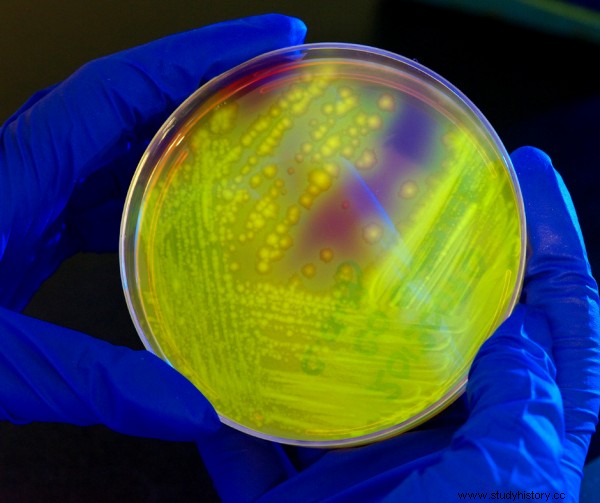LUCA, the common ancestor of all living organisms on Earth, passed on to its descendants survival traits in the form of genes. Some of his offspring - presumably large - did not survive. But one group did. Bacteria appeared 3.5 billion years ago and are today the most numerous type of organism on Earth.
Bacterial cells, whether they live in a backyard, in the depths of a hot sea or in the Arctic, in a silty pond or desert, in the men's toilet at Grand Central Station, or as toxins or probiotics in our colon, must perform many of the same important tasks that humans do to stay alive and healthy:avoid dangers, detect and absorb nutrients and energy sources, and maintain proper fluid and electrolyte levels.
And in order for their kind to survive, they must reproduce. Like us, they meet many survival needs, including by interacting with the environment in behavior.
One for all
Since the entire body of bacteria is contained in a single cell, there are no extra cells to make up the separate sense organs, muscles or nervous system to coordinate sensory and movement activities. A single cell works alone.
Many bacteria are mobile and use their incessant chaotic movement in everyday survival. They move thanks to molecular motors that control fibrous projections called flagellates. They use two types of movement to move:"swimming" and "tumbling". When all the flagella rotate counterclockwise, the bacterium flows in a directed direction, and when the flagella rotates clockwise, the bacterium tumbles.
Mobility has both benefits and costs. It requires flagella, and movement of the flagellum uses a huge part of the bacteria's daily energy supply. On the plus side, mobility gives you more opportunities to get food and avoid dangers. The primitive movements of bacteria, as we mentioned, are called taxis, orientation reactions towards beneficial substances and in the opposite direction to harmful substances. Useful substances are called attractants, and harmful substances - repellants. Taxias are found only in mobile organisms and therefore differ from the tropisms of the stem, leaves or roots of stationary plants; in the case of taxis, the whole organism changes its position in space.
Taxis are initiated as a result of the detection of attractants or repellants by the receptors. Some receptors are sensitive to the concentration of chemicals in the environment (chemoreceptors), others to light (photoreceptors). Behavior under the influence of chemical compounds is called chemotaxis, and behavior under the influence of light - phototaxis.
The tumbling action depends on the momentary situation of the bacteria. When an attractant is detected, the tumbling is reduced, resulting in the bacteria flowing towards the substance. On the other hand, the presence of the repellent increases the rollover, which causes a change in the direction of movement and withdrawal. The occurrence of tumbling or swimming depends on the molecular signals sent by bacterial receptors; the strength of these reactions depends on the concentration of the stimulus (chemical or light).
Warm, warmer, burns!
Bacterial cells also need to maintain an adequate volume of fluid in order to stay healthy; if there is too much water, the cell will explode, and if there is too little water, it will implode. This process involves a series of complex interactions between electrolytes (salts, e.g. sodium and potassium) and water. If the salt concentration is greater on the outside of the cell than on the inside, the water is removed, which balances the fluid-salt balance and prevents the cell from rupturing; if the salt concentration inside is too high, water is drawn in to prevent the cell from collapsing.
The same is true of maintaining fluid balance in various cells in the body in animals.
When our cells have too much salt, we drink fluids to draw the salt out of the cells and restore balance. Loss of fluid from vomiting, diarrhea or strenuous exercise reduces the amount of electrolytes, which upsets the cellular balance; electrolytes and fluids must then be replaced, for example by drinking electrolyte-rich drinks (such as Gatorade) or, in severe cases, by drip.

Bacterial cells also need to maintain adequate fluid volume in order to stay healthy; if there is too much water the cell will explode and if too little it will implode.
Many animals have physiological mechanisms that maintain a constant internal temperature despite changes in outside temperature, because temperature fluctuations can disrupt the physiological processes and chemical reactions necessary for cell survival. Animals also use behavior to thermoregulate - we undress or look for shade. when it's too hot and we put on new layers of clothing when it's too cold; some mammals shed their hair periodically; birds migrate.
Meanwhile, bacteria, instead of keeping the internal temperature around the set point, reconfigure certain biochemical processes to adapt their physiology to the external temperature. Perhaps it was this trait that determined the ability of early unicellular life forms to survive in a variety of climates. But beyond that, bacteria sense the outside temperature and use behavior to adapt to the outside environment.
More fun in the group
Bacteria, like all organisms, must reproduce in order to survive over time. For humans and many other animals, reproduction usually requires the participation of another organism. In bacteria, however, it is simply a question of cell division. Sex emerged as a modification of cell division in unicellular protists and would not have existed without the asexual form of reproduction that bacteria have used for billions of years.
Although reproduction itself is not a social activity in bacteria, they are in a sense social organisms - they often clump together on surfaces and secrete chemicals that literally stick individual cells together. Such clusters are called biofilms.
Plaque, goo on a shower wall or an electric toothbrush, and many slimy things in nature are examples of biofilm. Recent studies have shown that these cells are not only passively attached to each other, but communicate by generating electrical signals with which they coordinate food intake and reproduction, and attract new members to the group.
Many of the behaviors that, in more complex organisms, belong to interpersonal or social interactions, such as attracting to certain places or things or avoiding them based on smells, can actually be explained by similar simple factors.
What do the bacteria mention?
Bacteria can also absorb information about their world and use it to guide behavior in the future. For example, there is evidence that they create internal molecular representations of environmental conditions (temperature, oxygen levels) and use them to predict environmental conditions later so that they can respond appropriately. In other words, as we said, they may be learning and remember. While the evidence for bacterial learning is largely based on theoretical models, we have solid evidence for learning and memory in unicellular protists. Learning and memory do not require a nervous system.
We often adopt an anthropocentric view of memory, defining it as the ability to consciously recall the past. But memory is primarily a cellular function that allows the past to be used to modify the future functioning of a cell, whether in a single-celled or multicellular organism. The same can be said about much of our mental life and its manifestations in our conscious minds.

The above text is an excerpt from the latest book by Joseph LeDoux "The History of Our Consciousness", which has just been published by the Copernicus Center Press.
Consciousness, though useful to humans in many ways, which we will discuss later, is often a passive observer of behavior rather than its active controller, especially with regard to survival mechanisms that go back billions of years.
It is this ability of our brain to become aware of its own activity that allows us to ensure survival when we want to, experience fear, pleasure, and other emotions, and even use your free will to decide what to do next.
Source:
The above text is an excerpt from the latest book by Joseph LeDoux "The History of Our Consciousness", which has just been published by the Copernicus Center Press.
